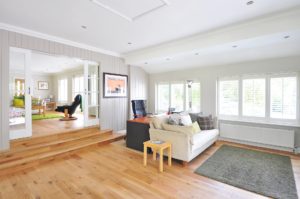Wood Flooring
How to Choose Wood Flooring
Wood Flooring Beauty
Wood Flooring also known as Hardwood floors is a popular choice with homeowners because of its versatility, value, and the way it enhances their homes' beauty.
Hardwood floors are made entirely of wood, while Laminate floors are made of compressed fiberboard with a paper pattern layer sealed on the top with an appearance of wood.
There are two types of hardwood flooring, solid and engineered. Here we will discuss the differences:
Solid hardwood flooring is made of one solid piece of wood instead of layers of wood. Solid hardwood floors are ideal for more areas at ground level or above and are nailed or stapled to the wooden subfloor. Thicknesses vary. The most common thickness is ¾”. 5/16″, thin profile options are less common and can be glued over hard surfaces such as concrete. There are many types of wood flooring from which to choose.
Engineered hardwood flooring is engineered from multiple layers of solid wood pressed together in a cross-ply (layer) construction—the grains of this type of flooring run in different directions. The construction makes it dimensionally stable and suitable for stapling, gluing, or floating over wood, concrete, or your existing floor. 3- or 5-ply construction is typically available. The most common engineered flooring thickness is ½”. It is a good option for all home areas due to its outstanding strength and moisture resistance. It works especially well in below-grade areas such as basements or radiant heated rooms.
Selecting a Flooring Option
Before selecting hardwood flooring for your home, these questions need to be answered:
- Where the flooring will be installed
- The type of subfloor in the area
- How much moisture will be underlying the surface
- The look of your floor
- What is your budget
The first consideration is the location, whether above or below grade. Above grade, areas are those above ground level. Below grade are below ground level, such as basements.
In either area, engineered flooring can be used due to its cross-ply construction. Cross-ply construction makes it more resistant to temperature and humidity changes. It can be stapled, glued down, or floated over existing flooring.
Wood Flooring
Solid flooring needs to be nailed to the subfloor and is susceptible to humidity and temperature changes. While it is ideal for more rooms in the house, it is not recommended where flooring is subjected to high moisture, humidity, or standing water.
- Hardwood flooring allows you to imprint your personal style; factors for consideration are:
- The wood’s natural color
- The applied stain
- maintained with special cleaners.
The floor care is determined by the type of finish your hardwood floor has – surface or penetrating. This will factor in how much is required to keep it glistening. Because most floors now have a surface finish, no longer is needed the water bucket and wax. You really need to sweep or dust mop weekly or use a soft brush vacuum attachment. Clean your floors occasionally with a no-wax floor cleaner that has been recommended by wood flooring professionals.
- The room’s lighting
- The character of the species
- The variation in grain and shade
- Strip or plank width
- Edge detail, including square, beveled, or eased
- High or low gloss
- Style and texture – rustic to contemporary
Wood Flooring Finishes:
A topcoat, or finish, protects and enhances the beauty of hardwood floors. Whether you choose a prefinished or site-finished floor, personalizing it to your style is an option.
Prefinished vs. Site-Finished:
Factory pre-finished floors come in a wide variety of colors, save your hours of labor, cleanup, and exposure to flames. They’re easier to install and endure better because they’re stained, finished, and dried in a controlled environment using high-performance equipment. Once a high-performance urethane coating is applied, pre-finished floors can receive up to 7 passes of ultraviolet light to cure the urethane, leaving a long-lasting finish. Most pre-finished floors come with a limited factory finish warranty.
With a site-finished flooring, your contractor or yourself must perform the work, yet you will have the flexibility to customize the finish.
Surface vs. Penetrating Finishes:
The most common floor finish, a surface finish, is easy to maintain. Once a stain has been applied, a top coat of polyurethane is then put on to protect the floor.
Penetrating finishes absorb into the wood fibers, have a matte or satin appearance, are topped with wax, which needs to be periodically reapplied and must be carefully maintained with special cleaners.
Floorcare is determined by the type of finish your hardwood floor has – surface or penetrating. This will factor in how much is required to keep it glistening. Since most floors now have a surface finish, no longer is needed the water bucket and wax. You really need to sweep or dust mop weekly or use a soft brush vacuum attachment. Clean your floors occasionally with a no-wax floor cleaner that has been recommended by wood flooring professionals.

